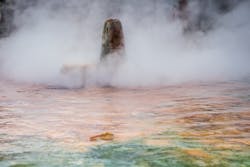About the author:
Goulds Pumps, located in Seneca Falls, N.Y., is a manufacturer of pumps for the industrial sector and water technologies market, producing a line of residential water well pumps. The Goulds Pumps' product portfolio includes submersible and lineshaft turbine, 4-inch submersible, jet, sump, effluent, sewage and centrifugal, as well as double suction, multistage, slurry and process pumps.
For more than 220 years people have journeyed to White Sulphur Springs, West Virginia, to indulge themselves in baths of mineral water flowing from mountain springs. The pilgrimage began in 1778, when Mrs. Anderson found relief from her rheumatism after soaking in the soothing waters.
Word of the “cure” soon spread, and more people began to visit the area to bathe in the water and extract its healing powers. In the early days, trees were hollowed out to form soaking tubs. As the site’s popularity grew, the regulars built a cottage community that evolved into today’s Greenbrier — a world renowned, award-winning resort and spa.
Research eventually proved that the water’s healing powers were limited at best, but by then Greenbrier had become one of the finest resorts in the world. Visitors continue to flock to Greenbrier to be pampered and enjoy an abundance of amenities and activities including the traditional soak in the sulphur waters. Indeed, since the 1920s, the mineral baths at Greenbrier have been the cornerstone of an extensive department that offers a variety of baths, packs, rubs, massages and physical therapy.
Although the sulphur water does not hold the mystical healing powers once believed, it does offer some therapeutic value: when infused with mineral salts the water helps extract impurities from the body to both relax and revitalize Greenbrier’s guests. That’s why “taking the waters” continues to be a popular part of the Greenbrier Treatment.
Countering Corrosion
As inviting as the sulphur water may be, it is equally harsh on the pipes and pumps that transport it.
“The water itself is benign, but when it reacts with the air it forms hydrogen sulphide, a highly corrosive gas,” says Matthew Stewart, director of engineering for Greenbrier. “It’s amazing what it will corrode. The original chrome-plated tub fixtures would not withstand the attack of the sulphur water, so we now install stainless steel tub fittings and grab bars.”
Over the years the staff at Greenbrier has learned that all the components used in the sulphur water’s delivery system must be made of corrosion-resistant material such as concrete, plastic, enamel or stainless steel including the pump.
“We’ve tried a number of different materials to pump the water,” Stewart says. “We used to use cast iron pumps with conventional bronze impellers, but they weren’t resistant enough to stand up to the attack of the hydrogen sulphide. We grew tired of replacing them.”
Eight years ago Greenbrier decided to stop the corrosion once and for all by installing an all-stainless model manufactured by Goulds Pumps.
“We looked for a pump with all stainless parts and housing so that everything that contacts the water is made of stainless steel,” Stewart says. “It’s the only thing that will last.”
Stewart noted that — even after years of use — the one-stage pump exhibited no side effects of corrosion. Indeed, it might have remained in service indefinitely, if not for the fact that the spa and sulphur water baths were expanded last year to provide guests with even more services. The project included a rebuild of the system that supplies the sulphur water to the baths.
Small But Effective
As the sulphur water collects in reservoirs it is channeled into a concrete collection tank. From there it is pumped through polyethylene pipes into two 6,500-gallon polyethylene holding tanks that feed the Spa’s enamel-coated soak tubs.
While the existing pump was corrosion-free and working well, it simply was not designed with sufficient foot of head to deliver the water to the holding tanks.
“The new system has about 230 feet of head and pumps 55 gallons per minute through 2,500 feet of 3-inch polyethylene line,” Stewart says. “The water is pumped up a hill over a fairly long distance, so we needed a pump that would provide lots of pressure.”
Greenbrier found what it needed in the Goulds Pumps Model SSV, a five-stage, all-stainless vertical pump. The model was chosen not only because it can stand up to the harsh environment, but because it is a workhorse in pony’s clothing.
“It’s a small, five-horsepower unit,” Stewart says. “But thanks to its five-stage design, it gives us the capacity, head and gallons per minute we need with very little current draw. If we would have used a single-stage pump it would have to have been at least 15 horsepower.”
Like its predecessor, the new pump should stand up well to the sulphur water’s corrosive properties, Stewart says. Indeed, he expects it to last at least 10 years — far longer than any cast iron model could.The recent renovations to the spa and baths are just the latest in a series of improvements intended to help Greenbrier maintain its reputation as one of the world’s best. Occupying an entire wing of Greenbrier, the spa now encompasses more than 37,000 sq. ft. It is one of the few American spas to offer European-style body treatments featuring natural mineral and sulphur waters freshly drawn from surrounding springs.
Download: Here
